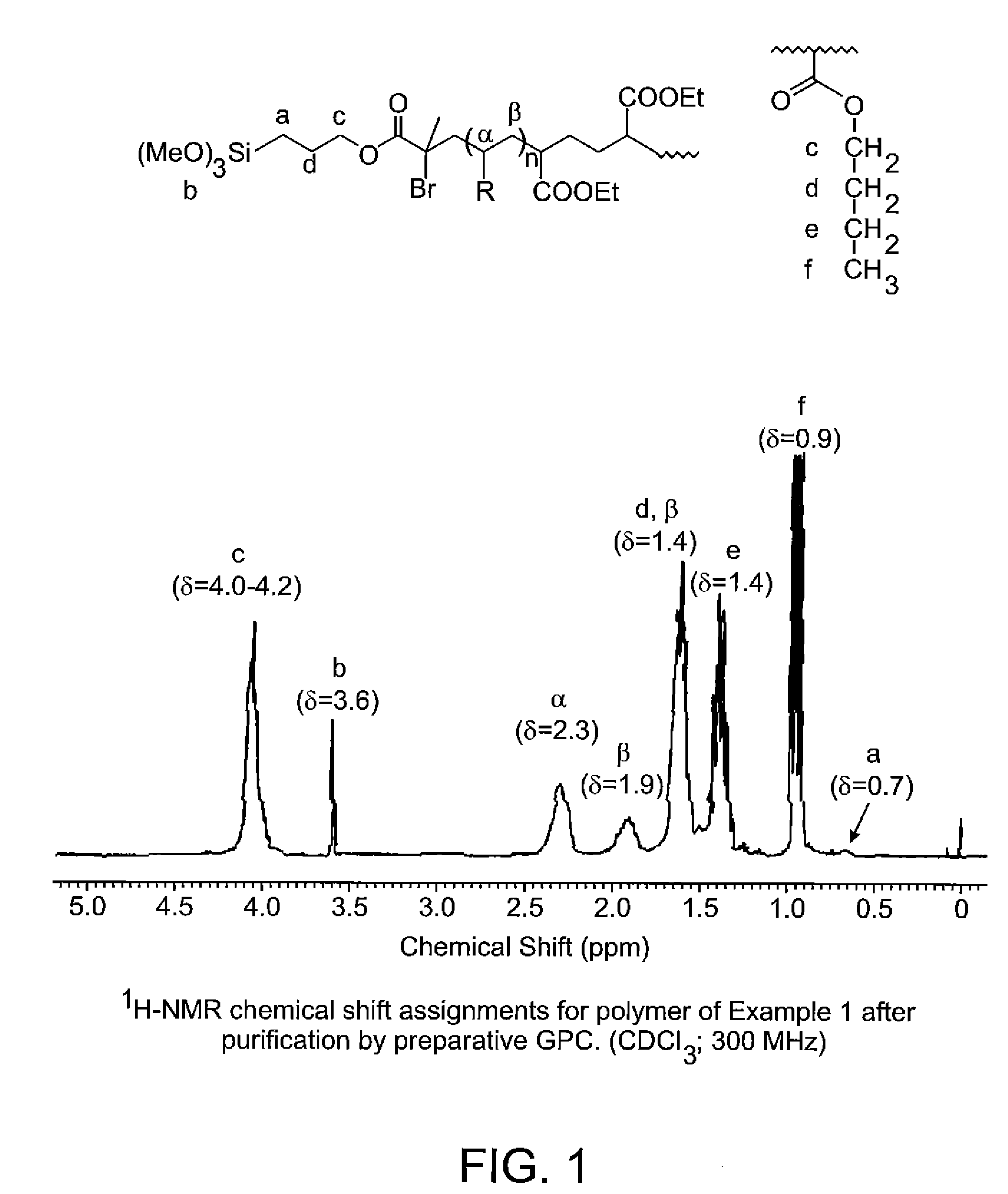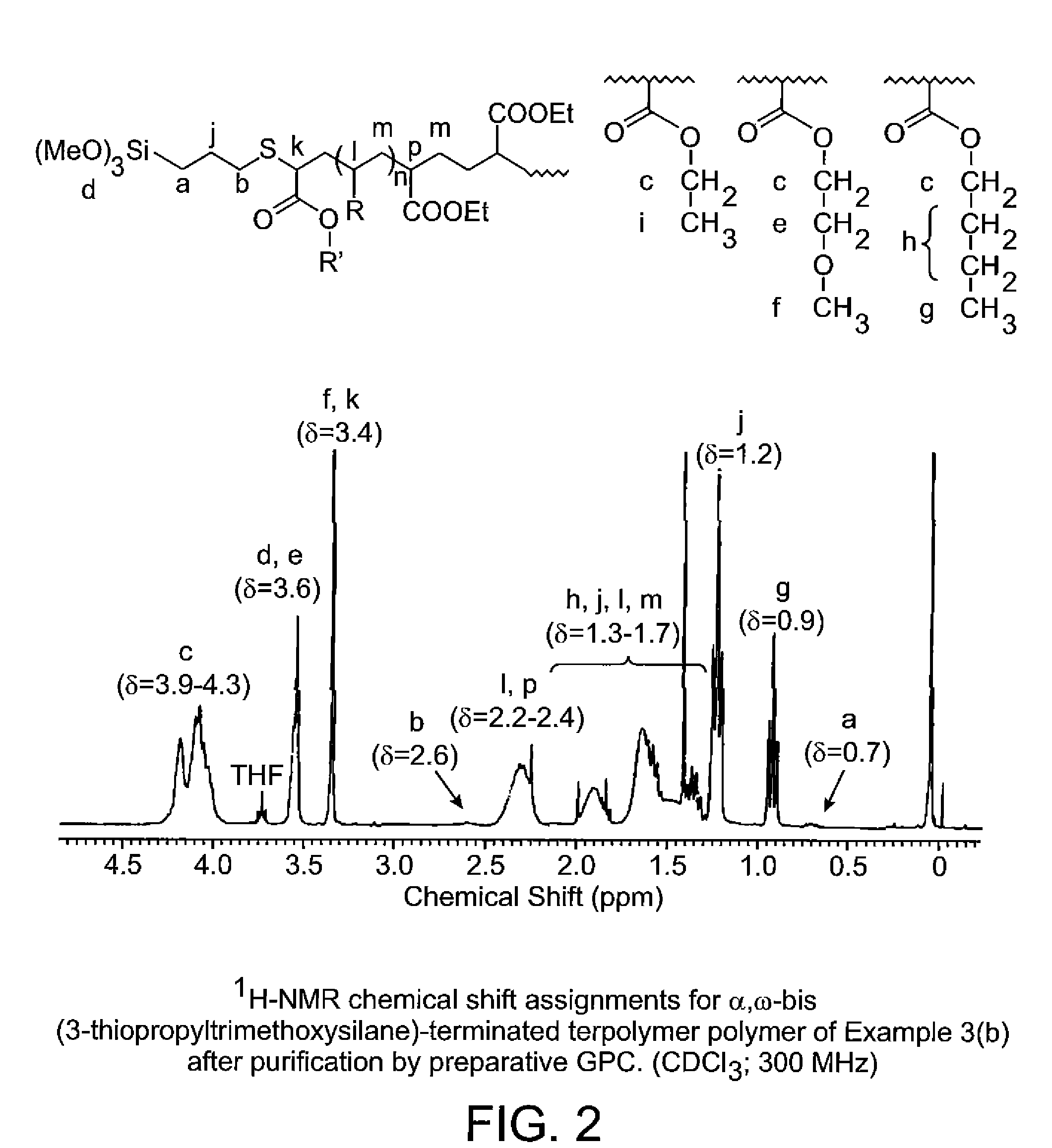Curable compositions with moisture-curable functionality clusters near the chain ends
a technology of functional clusters and compositions, applied in the field of polyacrylate with moisturecurable clusters, can solve the problems of limited cure speed of known crp polymers, less than desirable application shear modulus values, and less ability to tailor crp polymers to applications, so as to improve the overall functionality, enhance the cure effect, and enhance the cure
- Summary
- Abstract
- Description
- Claims
- Application Information
AI Technical Summary
Benefits of technology
Problems solved by technology
Method used
Image
Examples
example 1
Synthesis of poly(n-butyl acrylate) with Concentrated Enrichment of Chain Ends by trimethoxysilane Groups
[0054]
[0055]To an argon swept 500-mL jacketed glass reactor fitted with a stainless steel propeller blade and shaft, dry-ice condenser, thermocouple, ATR infrared (IR) detector probe and argon purge line was added n-butyl acrylate (248.16 g; 1.94 moles), copper powder (0.174 g; 2.74 millimoles, 6-TREN; prepared as described by M. Ciampolini, Inorg. Chem. 1966, 5 (1), 41) and anhydrous methanol (110 g). The mixture was cooled to 5° C. and degassed under vacuum at 50 torr for 10 minutes. The vacuum was released under argon and the vacuum degassing cycle repeated. Powdered diethyl meso-2,5-dibromoadipate (4.94 g; 13.73 millimoles) was then added to the stirred mixture under positive pressure of argon. The reactor was vacuum degassed as already described and the mixture than heated to 35° C. A mild exotherm was observed as the temperature reached a maximum of 48° C. and the solution ...
example 2
Synthesis of poly(n-butyl acrylate) with Dilute Enrichment of Chain Ends by trimethoxysilane Groups
[0064]To an argon swept 500-mL jacketed glass reactor fitted with a stainless steel propeller blade and shaft, dry-ice condenser, thermocouple, ATR infrared (IR) detector probe and argon purge line was added n-butyl acrylate (248.16 g; 1.94 moles), copper powder (0.174 g; 2.74 millimoles, 6-TREN) and anhydrous methanol (110 g). The mixture was cooled to 5° C. and degassed under vacuum at 50 torr for 10 minutes. The vacuum was released under argon and the vacuum degassing cycle repeated. Powdered diethyl meso-2,5-dibromoadipate (4.94 g; 13.73 millimoles) was then added to the stirred mixture under positive pressure of argon. The reactor was vacuum degassed as already described and the mixture then slowly heated to 35° C. over a period of about one hour. An exotherm was observed as the temperature reached a peak of 66° C. and the solution developed a green color. The mixture was cooled t...
example 3
Synthesis of di-functional 5 / 3 / 2 of ethyl acrylate (EA) / 2-methoxyethyl acrylate (MEA) / butyl acrylate (BA) terpolymer with thiopropyltrimethoxysilane ether End Groups
(a) Synthesis of Intermediate Dibromo-Terminated Terpolymer
[0066]
[0067]To a 3-L jacketed polymerization reactor fitted with a dry-ice condenser, mechanical stirrer, thermocouple, FTIR probe, argon purge, inlet port with rubber septum and vacuum line and modified with an external catalyst chamber connected to the reactor by means of a peristaltic pump was added ethyl acrylate (854.4 g; 8.53 moles), 2-methoxyethyl acrylate (666.3 g; 5.12 moles); n-butyl acrylate (437.5 g; 3.41 moles), dimethyl sulfoxide (541.5 g) and tris[2-(dimethylamino)ethyl]amine (1.356 g; 5.89 millimoles). The reaction mixture was stirred and cooled to 5° C. and a roll of copper gauze (30×30 screen; 33.4 cm×15.4 cm×0.03 cm) was placed in the catalyst chamber. The monomer solution was deoxygenated by vacuum degassing (45 minutes at 20 torr) and purging...
PUM
| Property | Measurement | Unit |
|---|---|---|
| temperatures | aaaaa | aaaaa |
| temperature | aaaaa | aaaaa |
| molar ratio | aaaaa | aaaaa |
Abstract
Description
Claims
Application Information
 Login to View More
Login to View More - R&D
- Intellectual Property
- Life Sciences
- Materials
- Tech Scout
- Unparalleled Data Quality
- Higher Quality Content
- 60% Fewer Hallucinations
Browse by: Latest US Patents, China's latest patents, Technical Efficacy Thesaurus, Application Domain, Technology Topic, Popular Technical Reports.
© 2025 PatSnap. All rights reserved.Legal|Privacy policy|Modern Slavery Act Transparency Statement|Sitemap|About US| Contact US: help@patsnap.com



